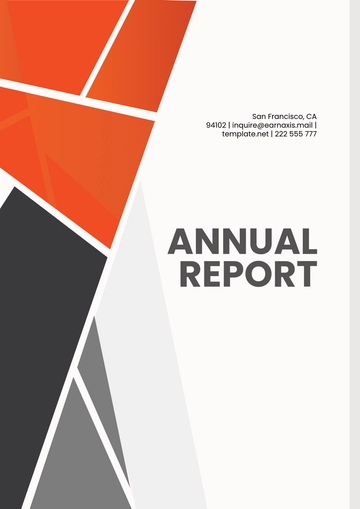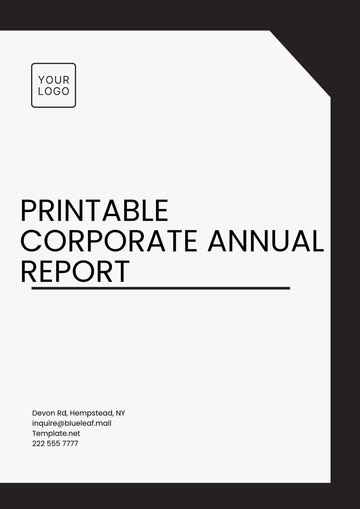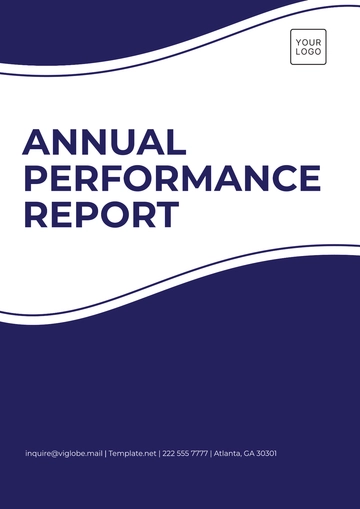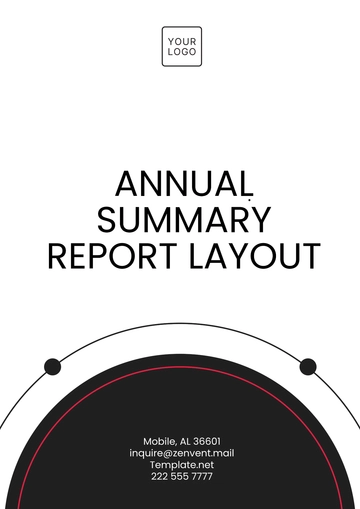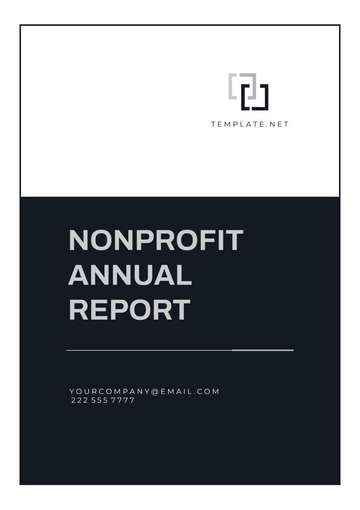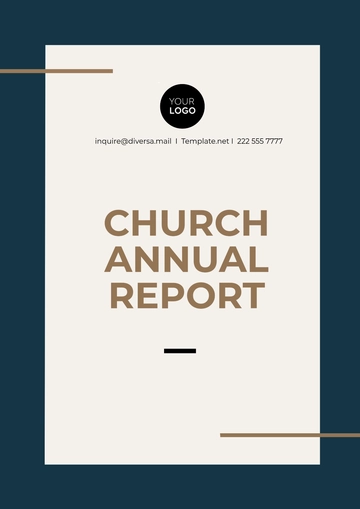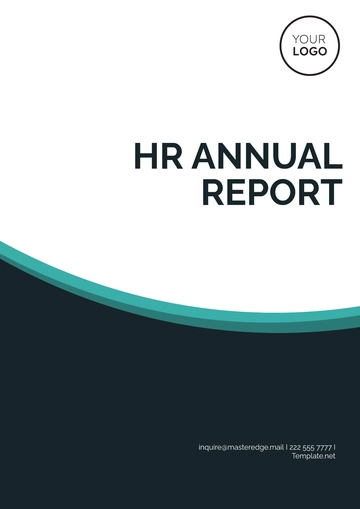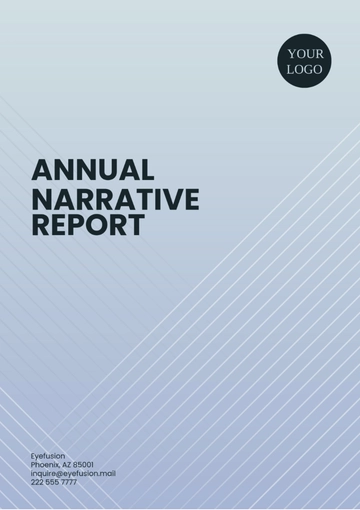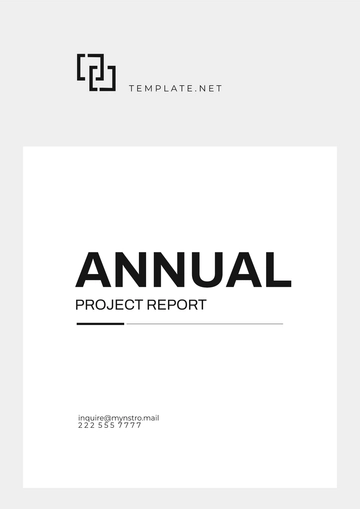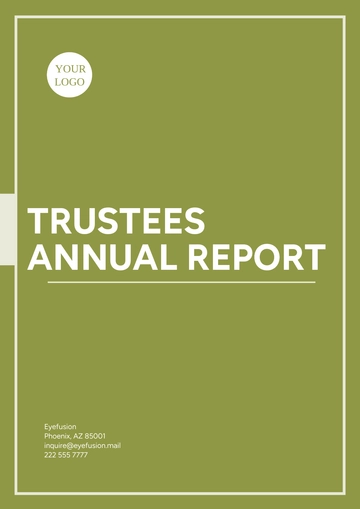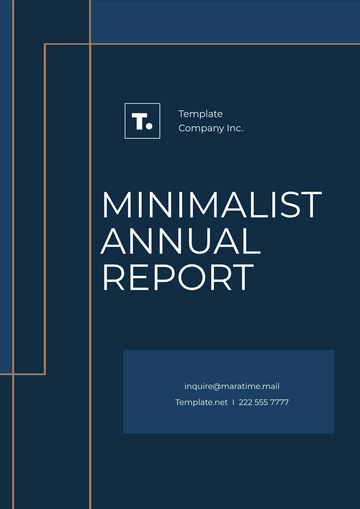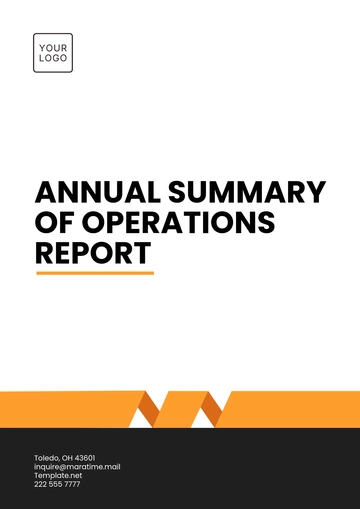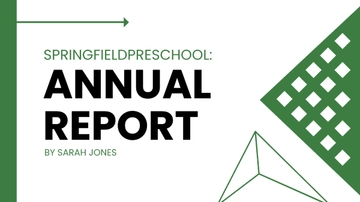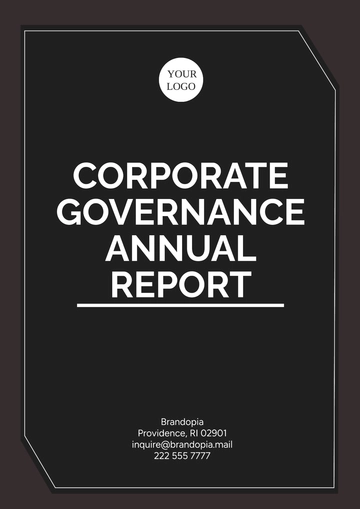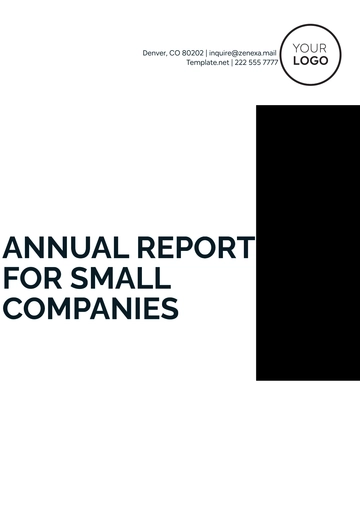Free Annual Health and Safety Report HR Format
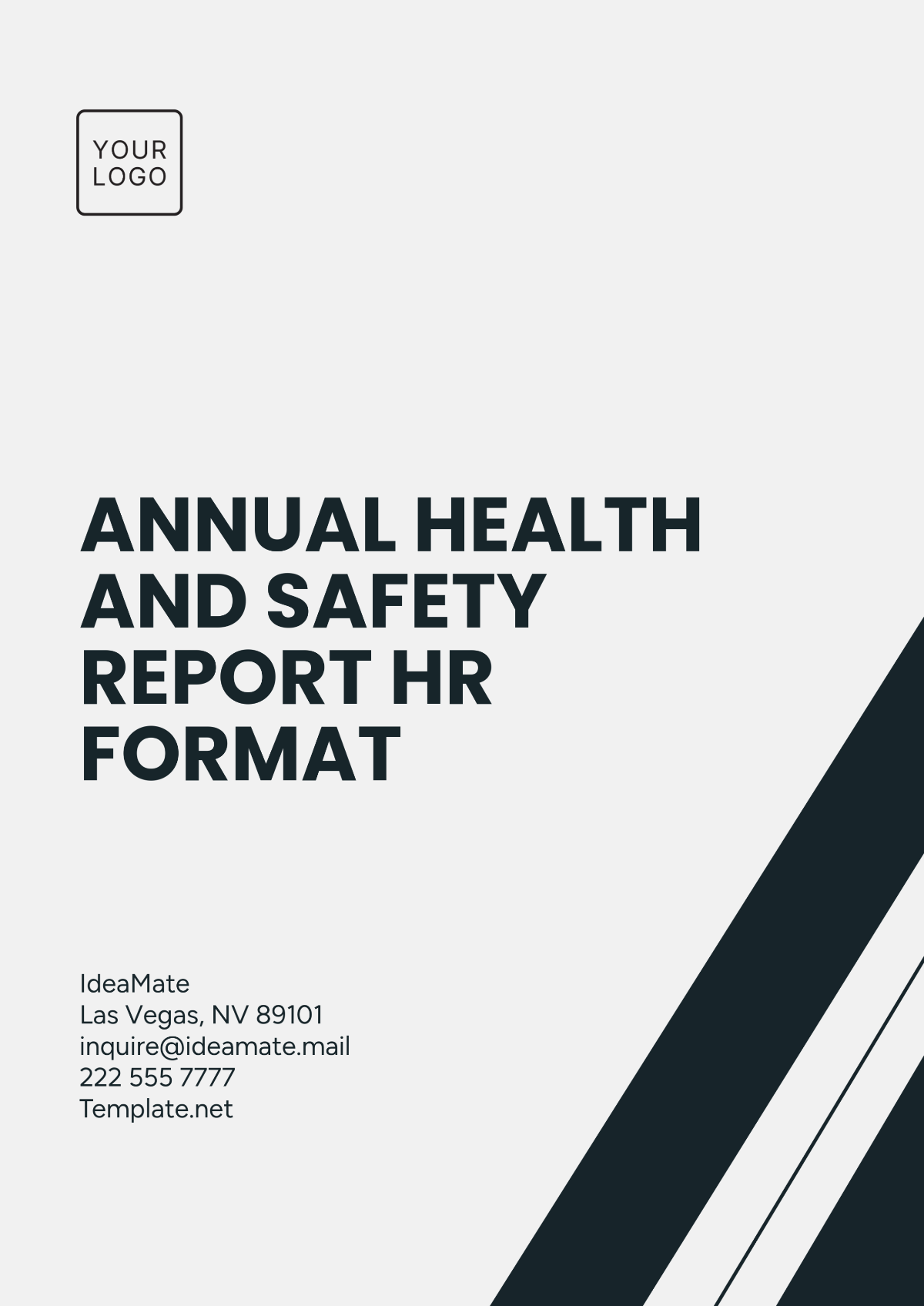
Prepared by: [Your Name]
Company: [Your Company Name]
Date: [Insert Date]
1. Executive Summary
This Executive Summary of this Annual Health and Safety Report encapsulates a detailed assessment of [Your Company Name]'s efforts and achievements in maintaining a healthy and safe work environment for the year [Year]. This report not only charts our milestones in implementing effective safety measures but also takes a critical look at the challenges faced in the operational landscape. Our fundamental goal remains steadfast—to cultivate a workplace that values both productivity and the health and safety of each employee.
The report is segmented into several key areas, including objectives, methodology, key findings, incident overviews, ongoing programs and initiatives, safety training, recommendations, and a conclusion. These sections collectively offer a 360-degree view of our company’s performance in health and safety matters. They also present data-backed insights, gleaned from incident reports, employee surveys, and safety audits, to guide future planning and improvements. By adhering to local, state, and federal guidelines, and often exceeding the mandatory safety requirements, we aim to set a high standard for occupational safety and health.
The information contained herein serves as both an introspective analysis of our company and a framework for our forthcoming initiatives aimed at minimizing risks and enhancing well-being. Therefore, this report plays a pivotal role in our continued pursuit of creating a safe, healthy, and productive work environment for all.
2. Introduction
This Annual Health and Safety Report stands as a testimony to [Your Company Name]'s unwavering commitment to maintaining a workspace that is not just efficient but also safe and conducive to overall employee well-being. We understand that the health and safety of our employees are not mere regulatory requirements but are instrumental in shaping a successful and ethical organization. They directly impact productivity, reduce absenteeism, and lower healthcare and legal costs, thereby adding value to both the employees and the company.
Our belief is simple: a healthy employee is a happy employee, and a happy employee is a productive one. With this philosophy at its core, this report serves as an annual check-in, mapping the course we have taken over the past year, including the safety initiatives launched, programs carried out, and policies revised or introduced. Moreover, it assesses the effectiveness of these actions, identifies areas that need improvement, and proposes strategies for enhancement.
The report is designed to be transparent and comprehensive, covering all aspects of occupational health and safety at [Your Company Name]. It includes data analysis, findings from safety audits, incident reports, and feedback from employees, ensuring a rounded view of our current status and the roadmap for future safety measures.
3. Objectives
The objectives section outlines the primary goals we aim to achieve to maintain and improve the health and safety standards at [Your Company Name]. By setting clear, actionable objectives, we create a roadmap for enhancing our workplace environment, thus benefiting both our employees and the organization as a whole. Each objective plays a significant role in shaping our overall safety strategy.
Compliance with Safety Regulations. One of the foremost objectives is to ensure compliance with local, state, and federal safety regulations. Staying abreast of these laws and guidelines is not just a legal necessity but also a moral responsibility. It creates a foundational framework upon which all our other health and safety initiatives are built. We regularly update our safety manuals, train our staff on compliance measures, and undergo audits to ensure that we are aligned with the current regulations.
Identify Risks. Proactively identifying and assessing potential hazards in the workplace is key to preemptively addressing issues before they become incidents. This involves regular risk assessments, safety audits, and inspections across various departments. The goal is to create a risk map that helps us understand where our vulnerabilities lie, enabling us to take targeted action.
Prevention. Once risks are identified, the next step is prevention. This includes implementing necessary safety measures like proper signage, safety equipment, and procedural changes to minimize risks. By doing so, we aim to create an environment where accidents are not just managed but actively prevented, ensuring the well-being of our staff.
Awareness. Last but not least, we aim to foster a culture of safety awareness among our employees. Knowledge is power, and in the case of health and safety, knowledge can be lifesaving. We conduct regular safety training sessions, distribute informative materials, and encourage open dialogue about safety concerns. By making safety a common vocabulary, we empower our employees to be proactive stewards of their own and their co-workers' well-being.
4. Methodology
The methodology section provides a detailed overview of the approaches and techniques used to evaluate the health and safety performance at [Your Company Name]. This involves a multi-step process that includes data collection, rigorous analysis, and benchmarking. By following a systematic methodology, we ensure that our assessment is both accurate and actionable, thus allowing us to make informed decisions aimed at continuous improvement.
Data Collection. The first crucial step in our methodology is the collection of relevant data. This is sourced from a variety of channels including incident reports, safety audits, and employee surveys. Incident reports help us understand the types of accidents that occur, their frequency, and the circumstances surrounding them. Safety audits give us an idea of the effectiveness of our existing safety measures, while employee surveys provide insights into the staff’s perception of workplace safety. Combined, these sources offer a comprehensive picture of the current state of health and safety in our organization.
Analysis. Once the data is collected, the next step is its analysis. We employ a range of statistical tools and software to process this information. By analyzing the data, we can identify trends or patterns that might not be immediately obvious. For example, a spike in similar types of incidents could indicate a systemic issue that requires attention. Likewise, feedback from employee surveys can highlight areas where improvement is needed, from better signage to enhanced training. Data analysis helps us understand not just what is happening, but why it is happening, enabling us to make targeted interventions.
Benchmarking. After data analysis, we engage in benchmarking to measure our performance against established criteria. This involves comparing our current data with past performance records to track progress over time. Additionally, we assess ourselves against industry standards and best practices to see how we fare in a broader context. Benchmarking provides us with valuable perspective, helping us to understand where we stand and what goals we should be setting for future improvement.
5. Key Findings
This section presents a summarized view of the most critical data points and observations collected over the past year concerning health and safety at [Your Company Name]. The table below provides a snapshot of these findings, offering a quick overview of the number of incidents, their common types, identified hotspots, and employee participation in safety training. This data serves as a starting point for a more in-depth analysis and discussion that will follow.
Aspect | Details |
|---|---|
Number of Incidents | [Description] |
Most Common Incident | [Description] |
Incident Hotspots | [Description] |
Training Participation | [Description] |
6. Incident Overview
The Incident Overview section delves into the specifics of the incidents that have occurred over the past year at [Your Company Name]. Understanding the types and outcomes of these incidents is crucial for identifying trends, assessing the effectiveness of current safety measures, and planning future preventative actions. Below is a table that categorizes incidents by their type and outcomes, providing a more structured and detailed look at the safety challenges faced by our organization.
Incident | Category | Number of Incidents |
|---|---|---|
Incident by Type | Slips, Trips, and Falls Equipment-related | [Number] [Number] |
Incident Outcome | Minor Injuries Major Injuries Fatalities | [Number] [Number] [Number] |
Incident by Type
Slips, Trips, and Falls
The most commonly recorded type of incidents were slips, trips, and falls, with [XX] incidents reported. These incidents often occurred due to wet floors, uneven surfaces, or cluttered pathways. Recognizing this trend, it's clear that there's a need to reinforce safety measures such as proper signage and regular inspection of walking surfaces. Immediate corrective actions and awareness campaigns will be necessary to curtail these occurrences.
Equipment-related
Equipment-related incidents accounted for [XX] occurrences. These often involve malfunctioning machinery or improper use of equipment, which could result in serious injuries or even fatalities. Such incidents highlight the importance of focused training on equipment operation and scheduled maintenance checks as effective strategies for reducing these types of incidents. We are actively considering additional safety protocols, including pre-operation checks and restricted access to trained personnel only.
Incident Outcome
Minor Injuries
Minor injuries were the outcome in [XX] cases. Although these injuries did not lead to long-term harm, they still present a serious concern as they impact employee well-being and productivity. These injuries often resulted from the aforementioned slips, trips, and falls or equipment-related incidents. Addressing the root causes of these minor injuries is a priority, and corrective measures, including better training and increased awareness programs, are being evaluated.
7. Programs and Initiatives
This section provides an overview of the proactive measures we have instituted at [Your Company Name] to ensure a safe and healthy work environment. From wellness programs to safety training, these initiatives aim to not only react to safety concerns but to preemptively address them. Below, each program and its benefits are discussed in greater detail.
Wellness Programs. The Wellness Programs at [Company Name] are comprehensive, including benefits such as gym memberships and annual health screenings. These programs are designed to improve the general well-being of our employees, as a healthier employee is generally a happier and more productive one. Gym memberships encourage physical activity, which can lead to a reduction in stress and health-related absenteeism. Annual health screenings are vital for early detection of potential health issues, allowing for timely intervention and reducing the risk of more serious complications down the line.
Safety Training. Safety Training is another cornerstone of our commitment to a safe workplace. Regular safety drills ensure that employees are well-versed in emergency evacuation procedures, should the need arise. First aid training is also offered, empowering employees to take immediate action in the case of minor accidents or health issues. This not only serves to minimize the impact of such incidents but also fosters a culture of responsibility and preparedness among the workforce.
8. Safety Training
Safety training is an integral component of our overall health and safety program at [Company Name]. By equipping our employees with the knowledge and skills to respond effectively to various safety issues, we aim to minimize risks and improve workplace safety. The training programs are scheduled at regular intervals to ensure that all employees are up-to-date with the latest safety protocols and procedures.
Table of Safety Training Topics and Frequencies
Topic | Frequency | Description |
|---|---|---|
Fire Safety | Quarterly | Covers basic fire prevention techniques and procedures for evacuation. Updated to adhere to local fire codes and regulations. |
By maintaining a regular training schedule, we ensure that both new and existing employees receive timely updates on safety best practices, thus cultivating a culture of safety and well-being for all.
9. Recommendations
To enhance the safety and well-being of our employees, the following recommendations are made based on the analysis of key findings, incident overviews, and training participation rates:
Implement additional signage in identified incident hotspots.
Many incidents such as slips, trips, and falls occur in certain high-risk areas identified as "hotspots." Additional signage, including warning signs and informational placards, should be installed in these areas to guide employees and alert them to possible hazards. This can help in significantly reducing the occurrence of accidents in these critical zones.
Update emergency evacuation plans.
While our existing emergency evacuation plans serve the purpose, they must be updated to accommodate changes in the workspace or the introduction of new equipment. Regular drills should be conducted post-update to familiarize employees with the revised plans. It's also important to ensure that evacuation maps are current and prominently displayed in high-traffic areas.
Increase the frequency of safety audits.
Currently, safety audits are conducted annually; however, given the changing nature of workplace activities and the introduction of new equipment, it may be beneficial to increase the frequency of these audits. More frequent audits will allow for quicker identification of potential hazards, ensuring that proactive measures can be taken before an accident occurs.
By implementing these recommendations, [Your Company Name] aims to foster a safer working environment, thereby reducing the risk of accidents and improving employee well-being.
10. Conclusion
The Annual Health and Safety Report serves as an essential tool for [Your Company Name] to transparently present the state of employee well-being and safety in the workplace. It not only showcases the efforts made in upholding a safe work environment but also identifies areas for improvement. Through the analysis of data on incidents, training participation, and existing safety measures, we gain valuable insights that inform our ongoing strategies.
Our ultimate goal is to create a zero-incident work environment, a target that may seem ambitious but is necessary for the well-being of our most valuable asset—our employees. By continually revisiting and revising our safety protocols, incorporating employee feedback, and adhering to best practices, we are committed to achieving this goal and setting a benchmark for health and safety standards in the industry.
11. Appendices
A. Incident Reports
Sample Incident Report:
Incident Date: | |
Incident Time: | |
Location: | |
Individuals Involved: | |
Description: | |
Immediate Actions Taken: | |
Reported By: |
B. Employee Surveys
Sample Safety Awareness Survey:
Questions: | Strongly Agree | Agree | Neutral | Disagree | Strongly Disagree |
|---|---|---|---|---|---|
I feel safe in my working environment | |||||
Adequate safety training is provided. | |||||
C. Safety Audit Reports
Sample Safety Audit Report:
Audit Date: [Month, Day, Year]
Auditor Name: [Names]
Area Audited: [Specific department or area]
Findings:
Safety Signage: [Compliant/Non-compliant]
Fire Extinguishers: [Compliant/Non-compliant]
Emergency Exits: [Compliant/Non-compliant]
Recommendations:
[Specific actions to improve safety]
These are just sample formats to provide a general idea. The actual documents will be more detailed and specific to the nature of incidents, surveys, or audits conducted.
12. Contact Information
For any questions or further clarification regarding this report, please contact:
Email: [Your Company Email]
Phone: [Your Company Number]
- 100% Customizable, free editor
- Access 1 Million+ Templates, photo’s & graphics
- Download or share as a template
- Click and replace photos, graphics, text, backgrounds
- Resize, crop, AI write & more
- Access advanced editor
Unlock a safer, more productive workspace with our editable and customizable Annual Health and Safety Report HR Template only from Template.net! This comprehensive tool streamlines data collection, risk analysis, and action planning to protect your team and bottom line. Don't just meet regulations, start editing the template now with our Ai Editor Tool!
You may also like
- Sales Report
- Daily Report
- Project Report
- Business Report
- Weekly Report
- Incident Report
- Annual Report
- Report Layout
- Report Design
- Progress Report
- Marketing Report
- Company Report
- Monthly Report
- Audit Report
- Status Report
- School Report
- Reports Hr
- Management Report
- Project Status Report
- Handover Report
- Health And Safety Report
- Restaurant Report
- Construction Report
- Research Report
- Evaluation Report
- Investigation Report
- Employee Report
- Advertising Report
- Weekly Status Report
- Project Management Report
- Finance Report
- Service Report
- Technical Report
- Meeting Report
- Quarterly Report
- Inspection Report
- Medical Report
- Test Report
- Summary Report
- Inventory Report
- Valuation Report
- Operations Report
- Payroll Report
- Training Report
- Job Report
- Case Report
- Performance Report
- Board Report
- Internal Audit Report
- Student Report
- Monthly Management Report
- Small Business Report
- Accident Report
- Call Center Report
- Activity Report
- IT and Software Report
- Internship Report
- Visit Report
- Product Report
- Book Report
- Property Report
- Recruitment Report
- University Report
- Event Report
- SEO Report
- Conference Report
- Narrative Report
- Nursing Home Report
- Preschool Report
- Call Report
- Customer Report
- Employee Incident Report
- Accomplishment Report
- Social Media Report
- Work From Home Report
- Security Report
- Damage Report
- Quality Report
- Internal Report
- Nurse Report
- Real Estate Report
- Hotel Report
- Equipment Report
- Credit Report
- Field Report
- Non Profit Report
- Maintenance Report
- News Report
- Survey Report
- Executive Report
- Law Firm Report
- Advertising Agency Report
- Interior Design Report
- Travel Agency Report
- Stock Report
- Salon Report
- Bug Report
- Workplace Report
- Action Report
- Investor Report
- Cleaning Services Report
- Consulting Report
- Freelancer Report
- Site Visit Report
- Trip Report
- Classroom Observation Report
- Vehicle Report
- Final Report
- Software Report
